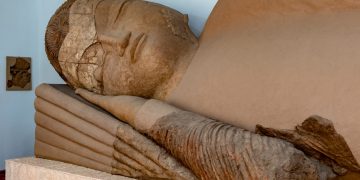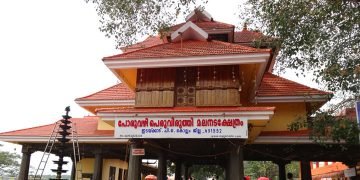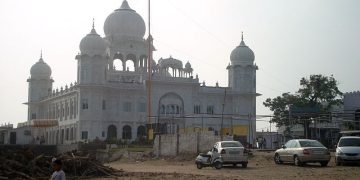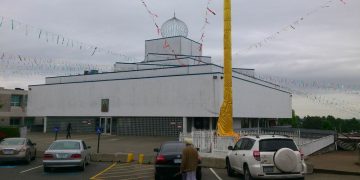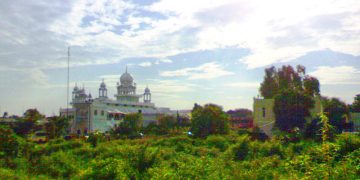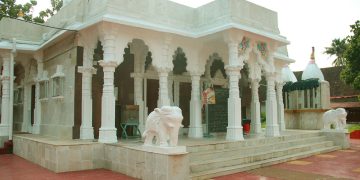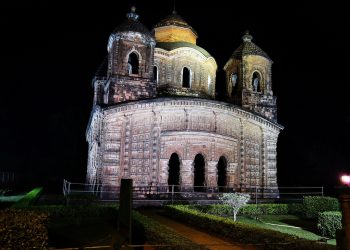Kamakshi Temple is an ancient Hindu Temple dedicated to Kamakshi, one of the forms of Goddess. It is located in the historic city of Kanchipuram, near Chennai, India and is popularly associated with Sankaracharya, one of the greatest Hindu gurus. The Meenakshi Temple in Madurai, the Akilandeswari temple in Thiruvanaikaval near Tiruchirappalli and this Kamakshi are the important centres of worship of Goddess, in the state of Tamil Nadu. The Temple was most probably built by the Pallava kings, whose capital was Kanchipuram.
Shrine’s History
The temple sanctorum consists of a deity Adivaraha Perumal? which is one of the 108 Vaishnaivaite deity worship temples.
The history reveals us that King Dasaratha performed Putra Kameshi Yagam? in the temple for the Birth of a child
to his kingdom. The King performed pooja to the Nabisthanam? of the goddess in the temple. The King Dasaratha within a few months received a child. The King Dasasratha belongs to the Ekshuvagu Vamsam? whereby the prime deity is Goddess Kamakshi. The extract of this story is visible in Markendeya Puranam?. The faith is if prayed truly the goddess provides the child for the childless couples.
The Saint Adisankara born at Kaladi in Kerala travelled across all the parts of the country. When he visited Kanchipuram he felt the goddess is in a ferocious mode that the entire sanctorum was very hot. So to personify her and accomplish to her to normal state the saint sung songs in the praise of goddess named Soundarya Lahari? then he established a Sri Chakra in front of her idol to keep her cool and personified. This Sri chakram is visible to all of us and all the poojas are done to Sri chakram too. The Saint established Sri Kanchi Kamakoti Peetam and attained Sarvagyna peetam in this holy city.
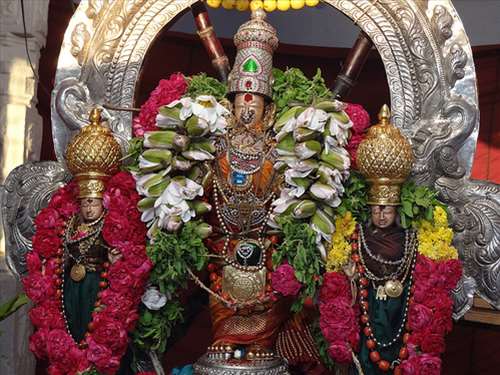
Legends Associated with This Shrine
The Goddess Kamakshi prevails in the form of Shakti. There are 51 Shakti Peetas across the country. The goddess residing place in Kanchi is called as Nabisthana Ottiyana Peetam?. The Goddess is called as Sri Kamakshi. The word is derived from the heritage Ka? means Goddess Saraswati , Ma? means Goddess Lakshmi , Akshi? means Eye. The name as a whole refers as the god lives in Kanchi with Goddess Saraswati and Goddess Lakshmi as her both eyes. Kanchi is also called as Satyavrita Kshetra . The Goddess worshipped Lord Siva by creating a mud idol in Kanchi. At that moment, Lord Siva incarnated as Kamba River with high tides to test the worship of the goddess, the goddess grasped the idol closely with her two hands from eroding in the tides. This prevented the idol from getting eroded in the floods. The goddess also performed Pooja by sitting in a needle tip surrounded by Panchakagni? to free herself from the interest of livelihood.
Lord Shiva became happy, gestured before her and married the goddess. Though there are many Shiva temples in the city, the only temple to have the sanctorum of the goddess is SRI KAMAKSHI AMMAN TEMPLE. There are also eight other Shakti goddesses surrounding the temple. The Goddess Mahalakshmi was given cursed by the Lord Vishnu to incarnate as Aarupam form. The Goddess Mahalakshmi comes to Kanchipuram and performs the worship chanting in the name of Lord Vishnu to free her from this Aarupam. After long prayers, the Goddess is freed from her Aarupam and given a Rupam by the Lord Vishnu. There exists a belief that Goddess kamakshi kumkum has to be offered to the idol of Aarupa Lakshmi within the sanctorum whereby the goddess Lakshmi will fulfil your needs on the prayer.
Architectural Relevance of This Shrine
The temple covers an area of about 5 acres, and the sanctum is crowned with a gold plated vimanam. Kamakshi is enshrined in a seated posture in the sanctum – and is referred to as the Parabhrama Swarupini, seated with Brahma Vishnu Rudra Eswara and Sadasiva. A Sri Chakram has been installed in front of the image and worship is offered to it. It is believed that Kamakshi was originally a Ugra Swaroopini and that Aadi Sankaracharya, upon establishing the Sri Chakra, personified her as the Shanta Swaroopini . It is believed that during the days of Adi Sankara, the presence of the Ugra Swaroopini was felt outside the temple precincts and that Sankaracharya had requested her not to leave the temple complex.
Symbolic of this, the festival image of Kamakshi, takes leave from Sankaracharya, at his shrine in the inner prakaram, each time she is taken out in procession. The layout of the temple is rather complicated. The outer prakaram houses the temple tank, and several mandapams such as the 100 pillared hall, the dwajaarohana mandapam etc. Imposing views of the golden vimanam can be had from the outer prakaram, which is pierced with four entrances on all four sides. Images of Vishnu are seen near the temple tank. One enters the four pillared hall then the inner prakaram, and climbs a series of steps, and reaches the sanctum. Immediately surrounding the sanctum are small shrines to Ardhanareeswarar, Soundaryalakshmi, Kallar and Varaahi. In this prakaram are shrines to Bangaru Kamakshi, Maha Saraswathi and Aadi Sankaracharya. Kanchipuram is the seat of the Kanchi Kamakoti Peetham established by Adi Sankaracharya. It is believed that Sankaracharya attained samadhi at Kanchipuram, although another school of thought holds that Kedarnath in the Himalayas is the site of his samadhi.
Shrine’s Map Location and How to Go There
By Road
Government operated or privately owned bus services and Guided tours are available from Chennai and Bangalore.
By Rail
Kanchipuram can be reached via Chengalpattu Railway Station on the Chengalpattu ? Arakkonam railway line. Daily passenger train services are also available between Chennai and Kanchipuram.
By Air
The closest airport to Kanchipuram is the Chennai Airport. Chennai is a well-connected international airport.
Shrine Timings
Darshan Timings Morning: 5:30am ? 12:00noon Evening: 4.00pm ? 8.00pm Pooja/Seva Pooja/Seva Abhishekam Morning ? Starts at 5:30 a.m. Afternoon ? Starts at 10:30 a.m. Evening ? Starts at 4:30 a.m. SanthanaKappu ? Sandal Darshan Every Wednesday and Saturday evenings PournamiPooja /NavavarnaPooja on (Full Moon day) Night 9:30 p.m. onwards every month SaharsranamaArchana Morning ? 9:00 a.m. to 10:00 a.m. Evening ? 7:00 p.m. to 8:00 p.m. AshtothramArchana Morning ? 7:00 a.m. to 12:00 p.m. Evening ? 6:00 p.m. to 8:00 p.m.
Events Celebrated at This Shrine
Four worship services are offered each day. The annual festival falls in Spring, in the Tamil month of Masi, which runs from mid-March to mid-April. During this time the chariot festival and float festival, are held. Other festivals include Navaratri, Aadi and Aippasi Pooram, Sankara Jayanthi and Vasanta Utsavam in the Tamil month of Vaikasi. All Fridays are considered sacred, though the Fridays in the Tamil months of Adi and Thai are celebrated.



